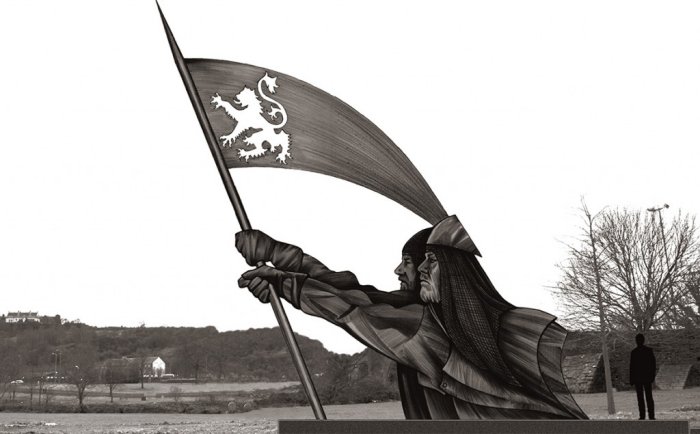|
Monday 14th March, 2016
GRAND DESIGN FOR WALLACE AND DE MORAY REVEALED
ONE OF the UK's most experienced public artists has been chosen to develop a major artwork at the site of the historic Battle of Stirling Bridge. This decision marks a watershed moment for The Guardians of Scotland Trust in a unique on-going fundraising campaign to enhance the site as a major visitor attraction in Scotland.
Malcolm Robertson, whose statue of comic icon Oor Wullie was recently unveiled in Dundee, has been awarded the commission to design a work commemorating the historic battle's two heroes, William Wallace and Andrew de Moray. The proposed design, a four metre high installation called Brothers In Arms, shows the two men shoulder-to-shoulder, with their arms aloft raising an eight metre high Scottish flag.
The Guardians of Scotland Trust (GOST) was set up four years ago to increase awareness of the historic battle, which took place at Stirling Bridge in 1297. A key aim of the Trust is to educate the public about the significance of Wallace's co-commander, Andrew de Moray, who died not long after the bloody battle of wounds suffered during the conflict.
The site lies directly beside Old Stirling Bridge, built in the early 16th century. This bridge replaced the old wooden bridge which gave the battle its name. It currently has very little to mark the importance of the battle, described by eminent Scottish historian, Sir Tom Devine, as being "second in importance only to Bannockburn in the Wars of Independence." The Battle of Stirling Bridge ended in victory for the Scots after Wallace and de Moray, who became known as The Guardians of Scotland, led outnumbered Scottish forces to victory against the much larger army of Edward I of England.

Artist's impression of the statue
GOST chairperson, Councillor Fergus Wood believes Robertson's proposed artwork could be taken quickly to the nation's heart, in the same way the giant Kelpies in nearby Falkirk have been.
He said: "The Trust aims to create an icon at Stirling Bridge which will bring together a glorious past and an exciting future for public art in Scotland. We are working in partnership with various organisations and companies to gives this important site its rightful place. In the future, visitors will come here and experience a sense of the site in Stirling and its significant place at the heart of Scotland's story. On a personal level, Malcolm's designs blew me away. They changed my view of what sculpture could be and the Trust is delighted to have him on board for this inspiring project."
For his grand design at Stirling Bridge, Mr Robertson has proposed an optical illusion which sees two giant hollow heads of Wallace and de Moray, made of corten weathering steel, appear and re-appear as visitors walk around them.
He explained: "When viewed from the front, the faces are seen looking forward to Stirling Castle. Because of the sculpture's unique 'hollow' construction, when viewed from behind, the faces seem to re-appear, and are seen looking back at the Wallace Monument. The heads are essential a three-sided structure which could act as an open shelter accessible to visitors. There is potential to become a focal point backdrop for gatherings and tourist trail events. The work will radically alter how the battle site is perceived. For me, this work is all about making connections between people and places. The partnership between Wallace and de Moray as equals is emphasised in all directions. I felt the need to steer away from conflict with this design, even though it is based around a battle. It's about building bridges and the common endeavour of the two men and the way they came together in order to get a job done. I also wanted to take advantage of the site’s midway relationship to the Wallace Monument and Stirling Castle by creating a figurative artwork that not only sits in the present, but looks back to the past and forward to the future at the same time."
Mr Robertson, from Fife, has used the idea of the optical illusion in a previous sculptural work commemorating the mining industry in Wales. Previous work in Scotland includes the new Oor Wullie statue outside the McManus Gallery in Dundee, the Jute Women Tribute in Lochee High Street, Dundee and a sculpture of a six metre high ships hull called Endeavour which sits at the entrance to Port Glasgow in Inverclyde. Mr Robertson succeeded David Harding as Glenrothes New Town artist from 1978 until 1991. This now internationally-lauded scheme was initiated by the former Glenrothes Development Corporation and saw the town artists taking the history of the area as inspiration and making art which today defines the identity of the town.
Project manager, Kathleen O'Neill said: "These ambitious plans depend entirely on public and private support over coming months. Anyone can be involved. Individual donations are most welcome and the project can offer magnificent marketing incentives to businesses, from the smallest to biggest, through national and international publicity. This is a major project for Stirling and Scotland."

Artist's model of the statue

| 


